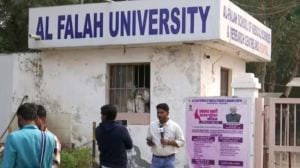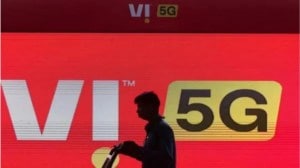One week into Maharashtra, the Bharat Jodo Yatra gets state Congress factions on board, also civil society
Rahul has been walking and meeting with each and every legislator of the party, including office-bearers, such as rivals Zeeshan Siddiqui and Suraj Singh Thakur, the current and former Mumbai Youth Congress presidents
 Rahul Gandhi has been meeting individuals -- children, youngsters, women and old farmers -- while walking. (PTI)
Rahul Gandhi has been meeting individuals -- children, youngsters, women and old farmers -- while walking. (PTI)One week into the march of Rahul Gandhi’s Bharat Jodo Yatra through Maharashtra, a familiar pattern is emerging — while the Congress party works to resolve internal problems of infighting and inactivity, civil society groups and individuals reach out to the platform to connect with the party itself.
“He (Rahul) asked me if I am a Congress supporter. I said no and told him that I was walking in the yatra for the sake of the Constitution. He said both of us were walking for India, which is a good thing,” said Darshan Mondkar, an entrepreneur and social commentator from Mumbai.
“I don’t belong to a party. But our country has never seen anything vitiating its social fabric of the magnitude as is happening now. I joined because I wanted to be part of the process that has begun to fix things in this country,” he said.
Mondkar is one of the many civil society representatives who are meeting Gandhi throughout the yatra and voicing their concerns. As the party’s general secretary in-charge of communications, Jairam Ramesh said in his press conferences that the Congress had lost its mass connect when in power. “We are rediscovering it now through this yatra,” he had said.
Sarika Pakhre, from Beed district, is part of Lek Ladki, an organisation that works against child marriage. “I am walking in this yatra with a message against child marriage. I want to meet Rahulji to tell him how these marriages take place even today, and the need to develop the rural economy to curb it,” she said.
Gandhi has been meeting individuals — children, youngsters, women and old farmers — while walking. “He asks about the person and problems. He asks if the person has any solution and what can be done. He is here to listen to others,” said a Congress leader from Maharashtra, who has been walking with him since the entry of the yatra in the state.
Fadtare Maharaj of Vidrohi Cultural movement walked with Gandhi, singing abhangas of Sant Tukaram. Pravin Kathale of Rashtriya Divyang Sangh from Pusad in Yavatmal said he joined the yatra as it aims to bind the nation together. Journalist and author Niranjan Takle also joined the march on November 8.
Scheduled meetings take place during the afternoons break. Ever since his entry into the state, Gandhi has met veterans working in co-operative sector, a delegation of unorganised sector workers, as we’ll as intellectuals and authors led by Professor Ganesh Devy.
A young filmmaker, Arvind Joshi, along with his team, is walking in the yatra to make a documentary film on its journey through Maharashtra, and how it is impacting citizens. His previous documentary film — Healing Hills, on the hills in Pune — will be released during the yatra by Jairam Ramesh, who was the Union minister for environment in the UPA government.
Ashutosh Shirke, a professional from Mumbai and part of Friends of Democracy — an informal group which works on strengthening democratic and constitutional principles — walked in the yatra for over four days. Shirke along with others run another group, Mahanirdhar, which organises study camps on constitutional values for youngsters. “When a girl in our group described that this yatra is a revolution, Rahul corrected her saying it was not and said that this yatra could sow the seeds of the future change,” said Shirke.
Shirke said Gandhi sounded very clear that this yatra was not meant only to win votes, but was certain that it was the beginning of a change. “It is more about connecting himself directly with the people of this country. We have seen that villagers line up curiously to watch him walk. He is visible to all, that too on the road. It makes a big difference,” he said.
Even as senior party leaders, including Gandhi, have been consistent about the yatra not being about winning elections, the walk has breathed life into the state Congress unit, revitalising support for the party and bringing warring factions together for the time being. According to sources, each district has been given a particular day on which they have to bring individuals to join the yatra. On November 12, thousands from Kolhapur, including a group of wrestlers, dancers and balladeers, joined the March, while on the next day, a similar number of individuals from Sangli could be seen at the march.
Gandhi has been walking and meeting with each and every legislator of the party, including office-bearers. Last week, he had MLA and Mumbai Youth Congress president Zeeshan Siddiqui and former Mumbai YC president Suraj Singh Thakur along with him in his walk. The two have been at odds with each other and are considered rivals within the party fold.
Vidarbha, despite being one of the strongest areas for the Congress has been infested with infighting. But as the yatra entered Vidarbha on Tuesday, a truce seemed to have been struck in the unit. When asked about it, Jairam Ramesh, in his press conference, said there was no question of any infighting, and that all of them are walking together to make the yatra a grand success.







